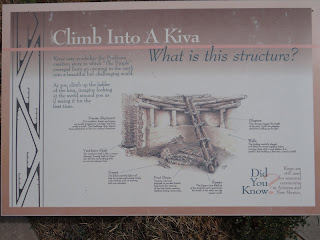Thursday, August 23, 2012
August 23: Emergence
Yesterday, we saw two Great Houses: the one in Bluff and another at the Edge of Cedars Museum in Blanding.
The latter is also the site of a Great House, but this one has been partially excavated for people like me who need visual help.
The entire site was a large Anasazi village settlement.
The Great Kiva has not been excavated, but a smaller kiva within the Great House itself has been restored and visitors are allowed to enter.
It is small, but small people fit well.
It has all the characteristics of a kiva:
entrance from the top, ventilation shaft, fire pit, foot drum, deflector (so the air from the ventilation does not blow out the fire), and a sipapu.
The sipapu is still the most sacred place in Pueblo kivas today. It symbolizes the hole in the earth out of which humans emerged. The kiva is the ceremonial and work space where humans are reminded of their origins and their spiritual status. There they "return," as it were, to their mother. When they leave the kiva, they ascend "out" from the earth into the sky and the surface of the world they inherited from their ancestors (animal,cosmic, and human).
The Puebloan way of perceiving reality is from the inside-out. One travels down and up--down to know yourself and up to emerge as a human. Life itself is like a pot.
Speaking of pots, how can these people have been primitive when they could produce an extraordinary diversity of fine pottery?
Each region had its own style of pottery making--color of clay, designs, material for temper, glazes, etc.
Each style of pottery enables archeologists to date a settlement and to assess cultural interactions.
An especially interesting exhibit in Edge of Cedars is a display and personal account of amateur hikers and enthusiasts who "discovered" artifacts quite unintentionally.
These artifacts turned up within the last few years, sometimes after a thunderstorm.
Rather than keep the artifacts for their own profit, though the federal penalties are stiff, these right-minded individuals left the artifact where it was and notified the appropriate authorities.
More and more people are realizing the importance of preserving our Indian ancestral past.
The museum contains a wealth of unusual ancient artifacts. One display shows an ancient set of finely crafted wooden dinner plates and stone knives with handles.
Another is an unusual sash made of macaw feathers that could only have come from Central America.
There are copper bells from Central America and other jewelry and ornamentation worn as daily personal identity and buried with the dead.
The museum has also added a lot of exhibits that were not here when we visited last year.
The most surprising one to me was an exhibit detailing a rock art project being conducted under the auspices of the Edge of Cedars Museum, the Bureau of Land Management, and rock art scholars like Sally Cole (whose books I am relying on, among others). They are documenting every rock art site in this region of southeastern Utah.
It makes me feel good to know that what we have been seeing and thinking is getting recognition by people who can make a difference.
But it is also going to add to my research agenda.
Subscribe to:
Post Comments (Atom)
















Love the pottery!
ReplyDelete